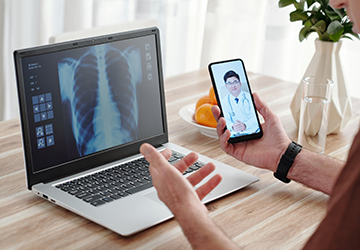Top 10 Emerging Technologies Revolutionizing Healthcare
Technological advancements and the COVID-19 danger we faced in 2020 are forcing the integration of healthcare and IoT technologies into the future. Things like remote consultation, therapy, and drug delivery become critical when the world stops. This situation has allowed healthcare providers and governments to test different technological approaches on a large scale. So the question is: how to perfect and integrate it into the post-epidemic era? Thanks to some of the most impressive tech we've seen today, here's how to do it.

1. Flexible battery
Foldable and flexible phones are no longer the subject of sci-fi movies and movies, as many brands are entering foldable phones targeting the consumer market. But much more is being developed and tested, such as bright clothing and flexible, interactive screens with numerous medical applications. Loose batteries are needed if they can power these flowing, flexible materials that are easy to fold and provide good charging in various conditions. Some working models will take time but will soon be in the hands of health workers.
2. RPM - Remote Patient Monitoring
RPMs have seen widespread use during and after the COVID-19 pandemic, reducing the cost and time required for consultations and diagnoses and providing patients better health tips and guidance. Integration with telemedicine and IoT further expands the range of applications to include monitoring vital signs such as blood pressure, heart rate, blood sugar levels, etc., without the need to visit a clinic or hospital. Many groups estimate that by 2023, more than 80% of healthcare providers and groups will invest heavily in these practices.
3. Electronic health records
Only through RPM can EHRs enable patients and physicians to share medical and healthcare information over the internet, which is possible when healthcare embraces holistic solutions. Most hospitals and healthcare providers now assign you a digital account containing your medical history and other information you can access immediately. It allows doctors to access information to understand better and provide more accurate advice. The better the EHR database and management, the better physicians can serve RPM patients.
4. Generative AI in Healthcare
When generative AI appears in a message or conversation, most people associate it with text generation and, more recently, image and video enhancement. Although still in beta, there is already a lot of research on generative artificial intelligence to support medical research to generate new drug variants. Theoretically, these drugs could target specific medical conditions, depending on the patient's condition. While there is still a long way to go, it shows significant progress in the amount of research being done.
5. Endeavor RX
EndeavorRX is an FDA-cleared game and should only be played or used with a doctor's prescription. The game is designed to treat children with ADHD between ages 8 and 12 to help them manage and learn from ADHD. Usually, gaming is an entirely different field, but as a technology, EndeavorRX can be considered an emerging healthcare technology since it is the first game in this field. Treatment with this game has little to no side effects and works well. After at least one month of treatment, over 70% saw and felt an improvement in their attention span.

6. Health wearables
Smartwatches and Fitbit wearables have been around for a long time, initially as healthy lifestyle companions. IoT, RPM, and other integrated healthcare practices and technologies connect to healthcare systems that share real-time medical information with physicians. Based on the trends and data collected by these devices, patients wearing these wearables can be provided with necessary medical care without the need to visit a medical facility or undergo testing.
7. Design the page
Designer phages are engineered viruses that target specific microbiome bacteria, boosting our immune system rather than causing disease. These phages also work on plants and animals for added health benefits. These phages are programmed to transfer basic codes into bacteria that make them follow specific instructions. Promising results have been achieved, starting with fighting E. coli infections, where it is possible to cut the tendrils of the virus and let them die.
8. Nanomedicine
Using nanotechnology to target specific cells at the molecular or atomic level could have significant implications for many fields of medicine. Nanotechnology has made great strides in diagnostics, sensing, and sometimes imaging, as well as providing essential medical supplies for many medical devices. Extensive research is underway to help drugs target individual cells based on a patient's needs and medical history.
9. Using cloud technology for data analysis in healthcare
We've already discussed how the Internet of Things (IoT) can be used for diagnostics, communication, and healthcare through telemedicine and other similar methods. Collecting and storing data is straightforward, which is what many cloud companies have been doing for decades. But the magic happens when this data can be sifted and analyzed to spot different trends and yield actionable results that benefit doctors and healthcare providers. More research and better data analysis can help patients make better and faster health diagnoses.
10. 3D bioprinting
3D printers have come a long way in recent years and show promise for making low-cost prosthetics. Research is ongoing to improve its suitability for higher quality prostheses and other aspects of human organ and tissue structures. To understand its potential, consider the case of a patient in Australia with chordoma cancer. Doctors managed to install full-size 3D vertebrae to relieve her pain. More research focuses on other aspects of the human body, such as knee and hip bone substitutes that last longer and are more functional than previous approaches.
To the future
As you can imagine from reading about the most promising and remarkable technologies in the medical field, there are countless other endeavors and opportunities to take advantage of. With more research and applications, scientific progress will bring us to a point where anything is possible.











